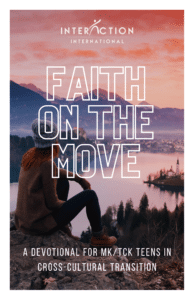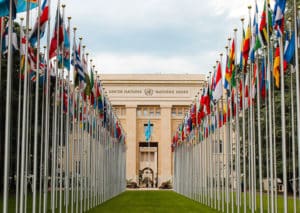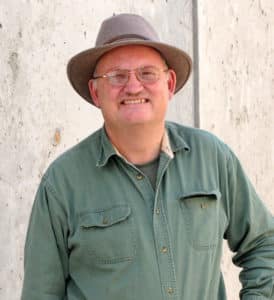An adaptable model for adaptable TCKs? Doesn’t it almost seem required for TCKs to have an adaptable model? After all, TCKs and adaptable are practically synonymous. So why shouldn’t the TCK model be adaptable, too?
In this fourth and final offering of this series, I humbly offer to the Third Culture community a model I’ve been developing to visually express BOTH Third Culture and a Third Culture Kid (Thanks Ruth Van Reken for bringing to my attention my errant co-mingling of those terms).
The Taylor Adaptable TCK Model offers three unique features (hey, if you are dealing with TCKs, and there are three parts, that must be a positive sign, right?). First, it allows for and recognizes Passport and Host Cultures generally have at least some similarities. Second, it keeps the Third Culture distinct from the Passport and Host Culture. Finally, it invites an overlay of an individual’s TCK experience to visually express themselves and how they connect with other TCKs of different backgrounds in the interstitial space we call the Third Culture.
I know it’s not perfect, and it has limitations. I concede there are some shortcomings to this model, and I will share some of those with you. If you find it helpful, I welcome you to utilize it (please cite your sources!). And if you don’t like it and want to rebuff my model…well I suppose I deserve it after my commentary on 6 Flawed TCK Models I did in the second piece in this series.
So here is the Adaptable TCK Model in its simplest form.
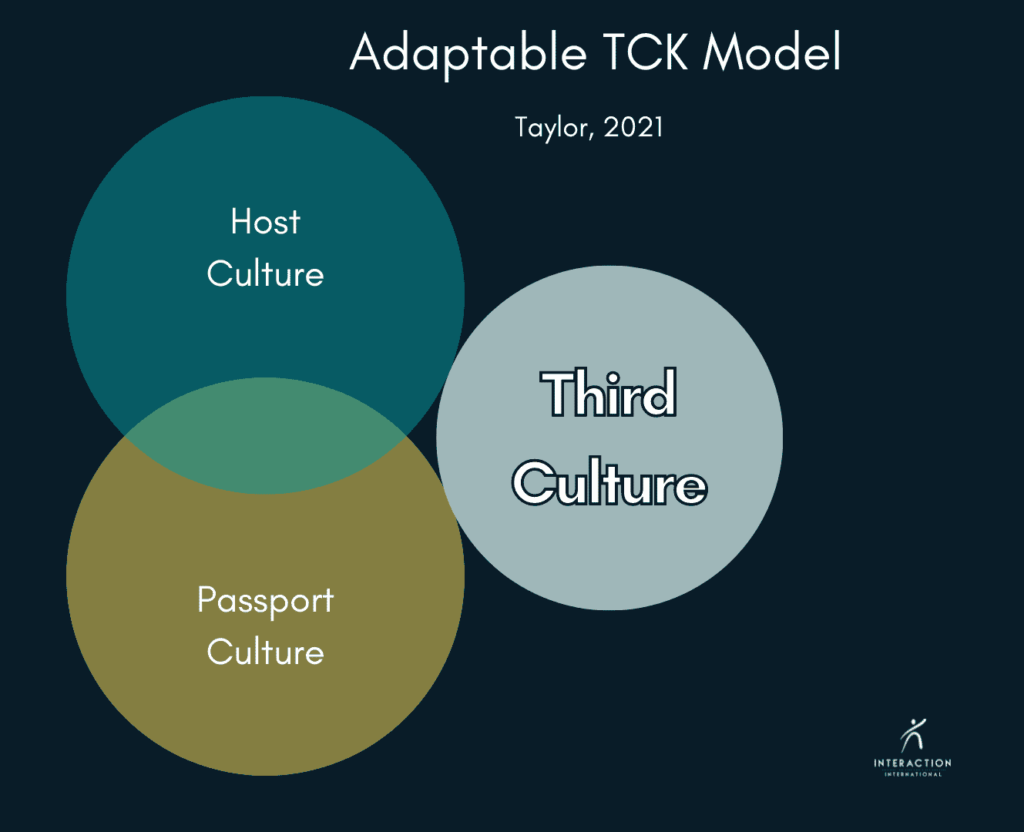
Sorry, was that anticlimactic? If you’ve journeyed through the previous posts it may feel like a low budget ending to a Netflix series you kept hoping would get better but just didn’t.
Before you close this tab to start searching travel sites for discounted international flights, hang with me a bit longer. Because I’ll unpack this model, add a few layers, and some explanations. Then you will be free to move about the cabin (this quip inspired because I’m literally writing this on an airplane).
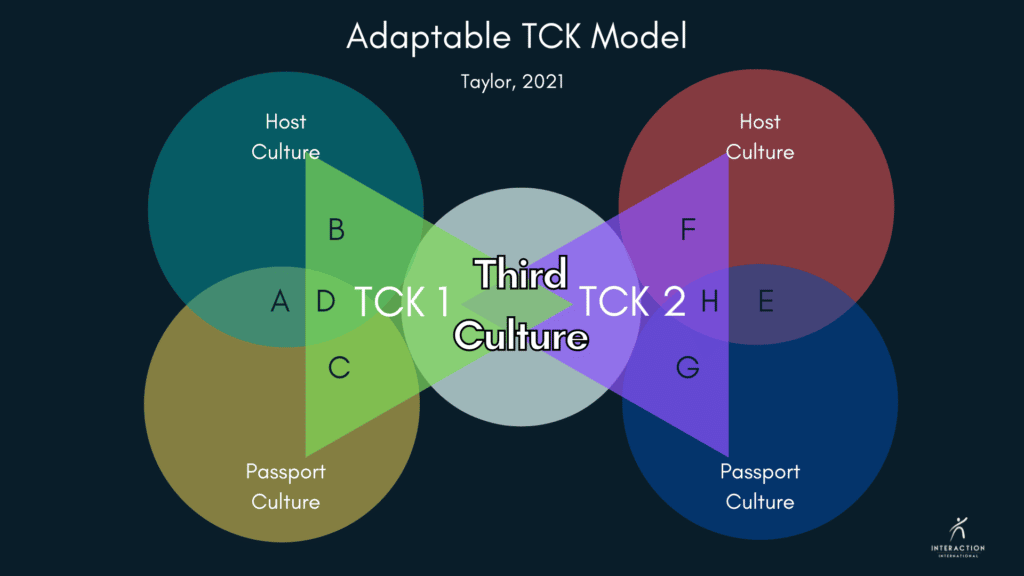
Was that too much too fast? Well, like a movie that teases you with the climactic scenes at the opening, I’m now going to start back at the beginning and add the layers back little by little.
A quick side note. Sheryl O’Bryan and I have been wrestling with the terms “Host Culture” and “Passport Culture.” Along with many others of you in the TCK community, you’ve probably been frustrated by issues caused by these descriptions. So, in a future article we will share with you our wrestling through these common TCK descriptors and suggest some potential alternatives. But for now I’ll continue to use these terms.
Back to the Adaptable TCK Model
In developing the Adaptable TCK Model, I began with the “Passport” and “Host” culture. I put them in vertical alignment because portrait looks better on Instagram- just kidding. In actuality that decision on the configuration had more to do with the influences of the two cultures and positionally how I wanted the Third Culture to interplay with them.
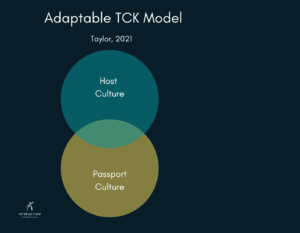
In my model I’ve intentionally arranged Passport Culture at the bottom and Host Culture on the top. The Passport Culture is the “root culture” if you will of a TCK. Their foundation. So, I chose to put this on the bottom. The other cultures from Host countries press in and build upon this cultural foundation. While TCKs may be saturated in their Host Culture through the majority of the day, the culture of their parents, their Passport Culture, is waiting for them each night when they get home, and it greets them the first thing every morning. No matter how many other Host Cultures are added, the “Passport Culture” remains a rare constant in their life experience.
In the Adaptable TCK Model, the nature of a Venn Diagram allows the overlay and intersectionality of the two cultural circles to show commonalities that exist between them. Host and Passport Cultures are not enemies or in opposition to one another. In fact they typically have at least some shared values, ideals, and practices. I believe it is valuable to acknowledge both the similarities and differences between cultures at play in a TCK’s life.
When you replace the generic “Host” and “Passport” with specific cultures, you have an opportunity to now reflect how much the two cultures interplay (thus the first reason why it’s an adaptable model).
Below are examples of how in application you would adjust the model to show the real-world interplay of the Passport Culture versus the Host Culture.
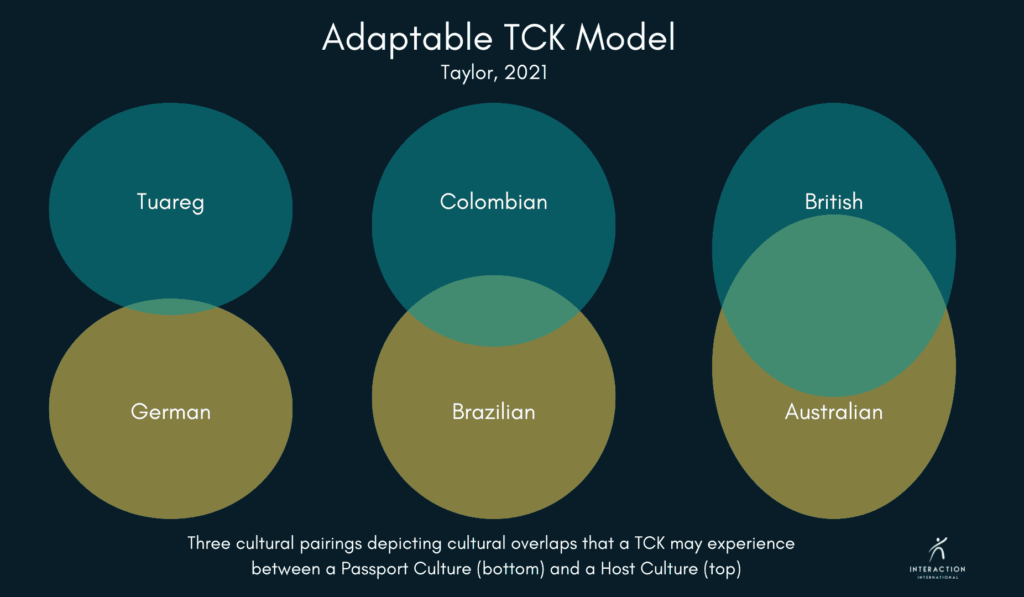
I believe there is value in having TCKs take stock of the cultural differences between their Passport and Host countries. Cultures that are very similar still have differences, and having an awareness of those differences can help reduce shock. On the other hand, cultures that seem to have very little in common still have areas of overlap. This is valuable to acknowledge when you are experiencing high stress and feel like everything is turned upside down.
In the three examples above I’ve suggested how different pairings of cultures may overlap in practice.
Adding the Third Culture
Once the Passport and Host Culture have been established in the Adaptable TCK Model, it’s time to add the Third Culture. I’ve intentionally added the Third Culture as ancillary and off to the side of the Passport and Host Cultures. The model now begins to take shape and looks like this:
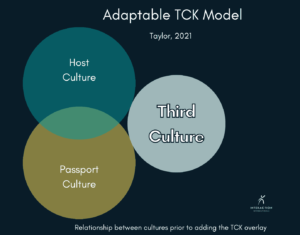
My rationale for placing the Third Culture to the side in that way is for two reasons. First, giving it a positional proximity to the side helps visualize the fact that the Third Culture is neither superior or inferior to either the passport or host cultures. It’s just a different part of who TCKs are. It’s special and unique, however Third Culture describes a TCK, but does not define them. I believe it’s important for Third Culture Kids to get to the point where they can say in their hearts that the Third Culture is a part of who they are, but it is not all they are.
Second, while nearly every model of Third Culture I’ve seen overlaps with the culture of parents and their Host Culture, in my thinking, Third Culture should actually be set apart and distinct from either (curious, did you read that I-ther or E-ther, because I intended the former). Unlike other “regular” cultures of the world, Third Culture is wholly distinct because it is birthed out of a collision of two or more separate cultural experiences in the context of high mobility. While traditional cultures by definition have homogeneous values, Third Culture is unique. It doesn’t have a geographic reference, a capital, a religion, a language, a special holiday, or nearly anything else that typifies a traditional culture. Yet Dr. Ruth Useem noted in her research the Third Culture, does have sameness despite the kaleidoscope of differences it comes from.
So, while a Third Culture Kid inevitably adopts pieces of their parent’s culture and their Host Cultures, the Third Culture is distinct from either of those. In my head I hear the beginning of an awkward child/parent conversation that begins with the question, “Mommy, where does Third Culture come from?” The parent stumbles with the words and eventually says, “When two cultures love each other, they sometimes make a new baby culture.” So, Third Culture is a 1+1=3 equation not a genetic Punnett square. If you take the baby analogy too far, genetically speaking, Third Culture is only made up of a mix of Host and Passport cultures–-and that’s the opposite of what I’m trying to say.
To drive this home a bit more, if we think about Third Culture as being a distinct culture in the same way we would think of Chinese culture or South African culture, what practical cultural correlations does the Third Culture have with other cultures? Admittedly I’m not a cultural anthropologist in the slightest (I don’t even play one on TV), but when I ponder “normal” world cultures, I wonder if Third Culture has commonalities with any other culture.
In my mind the closest potential cultures to Third Culture might possibly be what I would describe as geographically mobile cultures– for example the Roma or Tuaregs. At some point I would love to see someone do a study on the Roma and/or Tuareg cultures and explore what (if any) similarities might exist between them and the Third Culture. I anticipate that despite, for example, the high mobility associated with the Roma, Roma culture doesn’t overlap significantly with the Third Culture. I would extrapolate that the occasions where Roma kids in their high mobility interact significantly with other cultures, it actually spawns Third Culture. So some Roma may in fact be TCKs. Did anyone say doctoral thesis topic? One, two, three… not it!
Adding the TCK to the Adaptable TCK Model
With the foundations of Passport, Host, and Third Culture, the Adaptable TCK Model goes to a place where no other model I’ve seen goes. The Adaptable TCK Model includes both Third Culture and a Third Culture Kid.
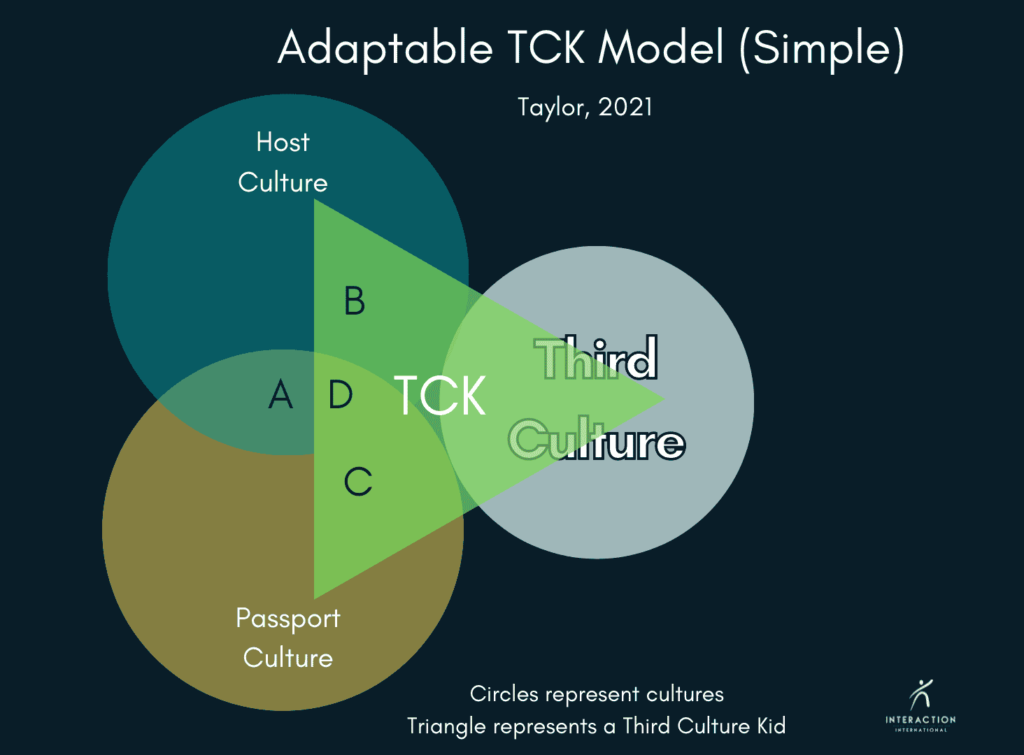
In this graphic, an individual TCK is represented with the green triangle shape. Why a triangle? Because it has three sides of course- in keeping with the theme of three! But sincerely, it also graphically helps the individual TCK to stand apart from the different cultures represented by circles.
The model illustrates that a Third Culture Kid captures aspects of their Passport Culture, their Host Culture, and also the Third Culture. In my 20 plus years of experience of working with TCKs, I spend a lot of time highlighting the unique challenges and beautiful benefits of having Third Culture. But at the end of the day, I worry that in my limited time with TCKs, I neglect to reinforce that they also have their other rich cultures to pull from as well (Passport and Host).
I’d also like to highlight that as a Venn Diagram, the Adaptable TCK Model denotes specific unique elements potentially adopted and excluded by a TCK. Sections marked with A, B, C, and D help point out the nuances that exist for the TCK. For example B and C represent mutually exclusive cultural values from their respective Host and Passport Cultures. For example a TCK may adopt each cultural language and become bilingual. The TCK is also likely to naturally and quickly adopt cultural values that overlap between between Host and Passport Cultures denoted in part D. And while it may not be significant, it’s also possible the TCK does not adopt parts that both Host and Passport Cultures have in common—characteristic A. While not highlighted with a label, TCKs by definition embrace parts of the Third Culture.
For me, the Venn Diagram allows for good conversations to take place with a TCK. Identifying the way they embrace (or resist) the cultures that are around them and have played a part in their life is a great exercise in understanding personal identity. Within a family unit, even siblings may adopt cultural values differently. This leads to the design of the Adaptable TCK Model to express their TCKness individually.
Even More Adaptable
So, now we come to the second way the Adaptable TCK Model can be adjusted when it comes to practical application. Because not all TCKs are the same. Some embrace the Third Culture– they want to be proverbially branded (for that matter, some literally get tattoos) as part of that culture. While other TCKs, generally those with limited exposure to a Host Culture and low mobility, don’t connect with many of the Third Culture attributes, and they actively deny their claim to Third Culture.
This is where, in practice, I would have an individual TCK adjust their triangle to best represent who they are as a Third Culture Kid.
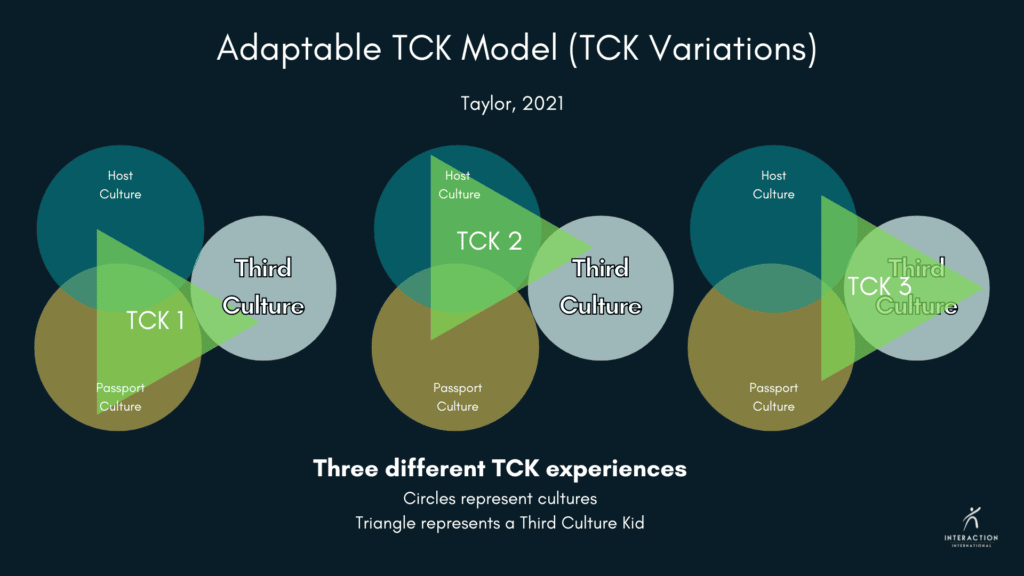
In the examples above, each triangle is adjusted to fit an individual. So for TCK 1, this Third Culture Kid could spend a significant amount of their life in the US, but only did two short deployments with their parents on a US military compound in South Korea. This diagram allows the TCK to visually say they liked kimchee and to a degree resonate with Third Culture (experienced the grief of mobility), but they really feel quite comfortable with American culture.
TCK 2 might be an individual whose parents are from Colombia, but they have lived almost their entire life in the UK where their parents own a coffee importing business. This TCK has been educated exclusively in UK schools and rarely visits family back in Colombia. TCK 2 speaks English fluently with a British accent but has limited ability to communicate in Spanish. TCK 2 would probably identify themselves more as British than anything else. Yet the influence of both their Passport country and the Third Culture have influence and are evident in their life.
The final example, TCK 3, might be of a Global Nomad who has lived a highly mobile life as a diplomatic kid. The TCKs’ parents are French diplomats and every few years they are moved to a different country. This TCK has attended several international schools and generally boards. She has never really had a chance to put down roots anywhere (well except relationally, because that’s what happens in the Third Culture). TCK 3 would likely not resonate with the idea of living in France for the rest of her life nor with any of the assortment of countries/cultures where her parents have worked. The most significant, constant cultural influence in TCK 3’s life has been the Third Culture.
In all three, I want to note that a TCK usually does not fully embrace the entirety of any of the available cultures. A TCK in a way has an “all you can eat buffet” experience with the cultures impacting them. They pick and choose what they like and don’t like. I think the beauty of a TCK is that they can also pick up elements of a culture for a while (like being event oriented) but then later choose to embrace a time oriented approach to life–picking and choosing whichever best suits the situation. Unfortunately, TCKs are always at the mercy of the dominant culture in which they are currently living. So they exercise their cultural chameleon abilities and do their best to blend in, usually to the detriment to their own personal preferences.
Too many cultures cause chaos!
It is in relation to TCK 3, above, that I would like to acknowledge a known shortcoming of the Adaptable TCK Model. I haven’t figured out a simple way to allow for multiple Host Cultures (or even Passport Cultures) to overlap appropriately and still interrelate correctly. At best I could squeeze four cultures together, but it’s still not elegant, and it’s is hard to respect the way they share commonalities. For a TCK who has bi-cultural parents (or is adopted from another culture) who has also lived in two additionally unique cultures, they might express themselves something like this…
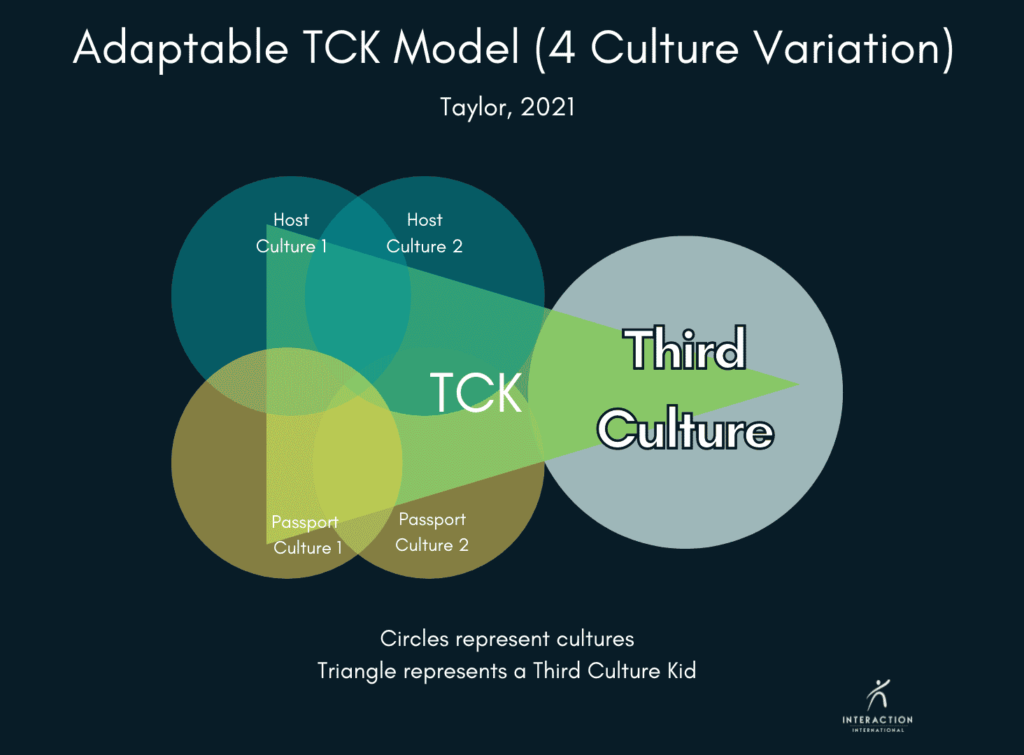
I know… it’s a mess. But maybe for some of you with those types of complex cultural backgrounds, it resonates with you.
There is no 4th Culture
However it’s in this picture with four “normal” cultures represented alongside the Third Culture I’d like to drive home yet again a frequent misnomer. This graphic depicts why there is no 4th Culture Kid. The number of cultures involved is not where the name (Third Culture Kid) derives its meaning. The Third Culture Kid is named because of their affiliation with the Third Culture. The TCKs can grab from any numerical amount of cultures, but at the end of the day there is only a Third Culture.
Why TCKs connect in the Third Culture
With the groundwork laid on the core of the Adaptable TCK Model, I would like to push it one step further and graphically represent what TCKs have intuitively known… they get each other in ways non-TCKs generally can’t. Even if TCKs have limited or no corresponding Host and Passport Cultures, they find unique community and understanding together in Dr. Ruth Useem’s Third Culture space.
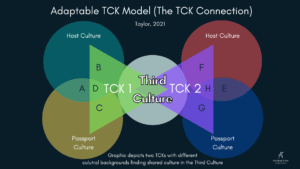
So in the final layer, this diagram depicts why two individual TCKs find a bond within the Third Culture. Each triangle represents a different TCK. They each have different sets of Passports and Host Cultures. But their global nomad lifestyles have birthed their shared Third Culture attributes. It is there they find a common ground. They experience that beautiful and, unfortunately, all too rare experience of a kindred spirit– found only in that interstitial space between cultures. It’s the “neither/nor” as Ruth Van Reken calls it. A space where transition hardships, grief/loss, airline stories, language blunders, wanderlust, and so much more is the vernacular.
Back to the RVR model
Ruth shared with me that in the early days when she presented her Third Culture model, she would layer the Third Culture transparency on top of the Host and Passport Culture (for those of you who remember the days of overhead transparencies, you’ll get that). She took a three dimensional explanation into a 2 dimensional projection in a beautiful way.
Between the 2nd edition and the 3rd edition of the Third Culture Kid book, the publisher reproduced her model differently.
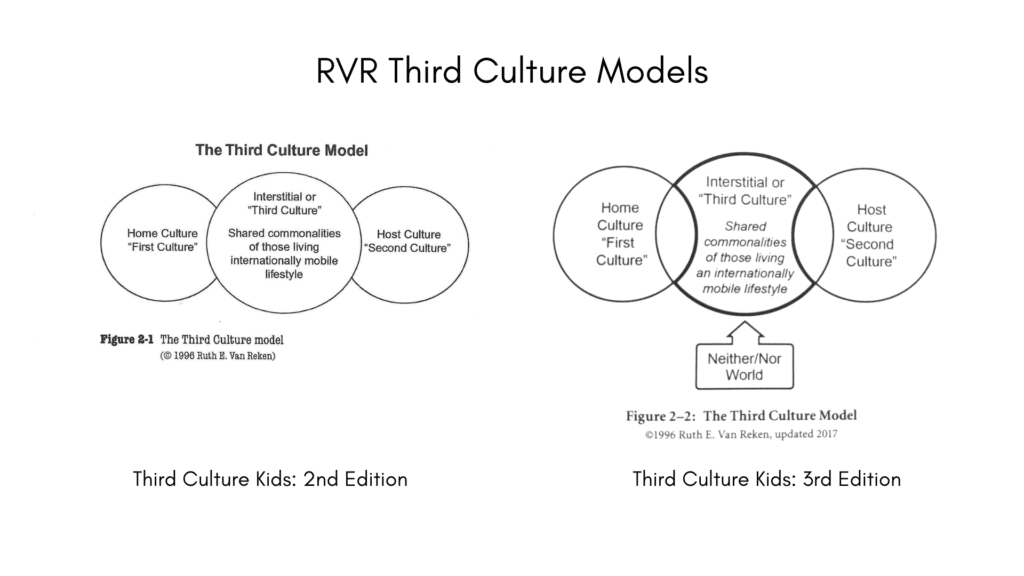
The variation between the two does make a difference. The version from the 2nd edition communicates closer to the way she would present it live. The third edition version of the model turns it into a Venn Diagram. The bold outline emphasizes the Third Culture, but the overlaps of the circles present questions. Rumors have it that there is a 4th edition of the TCK Book in the works. Time will tell.
I still like Ruth Van Reken’s model. It’s just simple and easy to understand. It communicates well the key principles of Third Culture. Honestly, I’ll keep sharing and teaching it because it remains the standard and is widely recognized.
So where does this leave things?
Whichever TCK model you use or speaks to your heart (well, hopefully not one of the flawed models from the second article in this series), let’s continue to celebrate the Third Culture and Third Culture Kids. Let’s recognize this culture’s diversity and beauty. TCKs, I invite you to play with the Adaptable TCK Model to see if it will help you better communicate who you are now and also who you were at various stages of your life.
Let’s continue to build a better awareness of Third Culture, a hidden culture among cultures, with the hopes TCKs will feel less isolated and misunderstood. As Third Culture is being brought slowly into mainstream conversations, my hope is TCKs everywhere might begin to finally experience a sense of belonging. Maybe, dare I say it, TCKs might even experience a sense of home.
PS – I’d like to give a special thanks to Holly Baldwin who turned my scrawlings into beautiful graphics far exceeding my expectations. Thank you to Matt Jones, John Barclay and Ruth Van Reken who gave rich feedback. And of course a big thank you to “princess” Sheryl O’Bryan for many long discussions coupled with heaps of encouragement- you got me to put this into words and share it with the wider community.
Bret Taylor is the Interim Executive Director of Interaction International. He’s been working with MKs/TCKs since 1999. He is co-host of TCK Live, directs the Transit Lounge programs, presents at Foundations of Organizational MK/TCK Care, chairs MKCS, and helps with Among Worlds–Interaction International’s magazine for and by Adult Third Culture Kids.
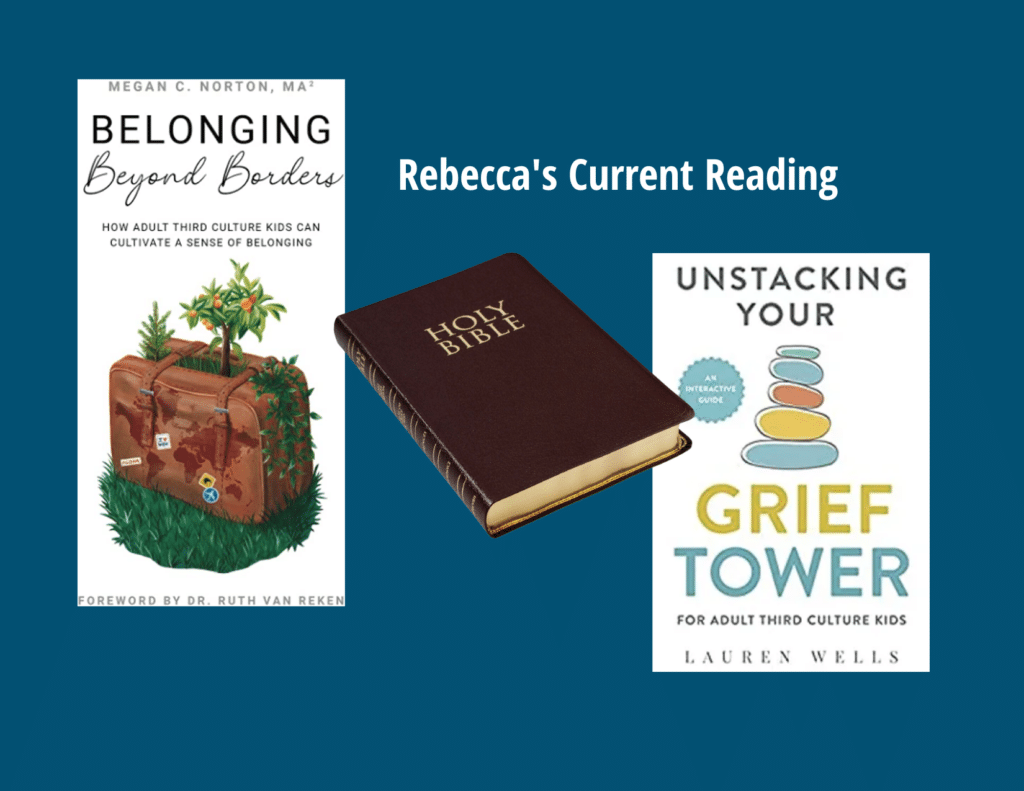



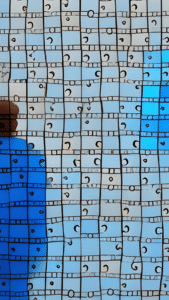 Looking for the Right Fit–right now!
Looking for the Right Fit–right now!


